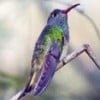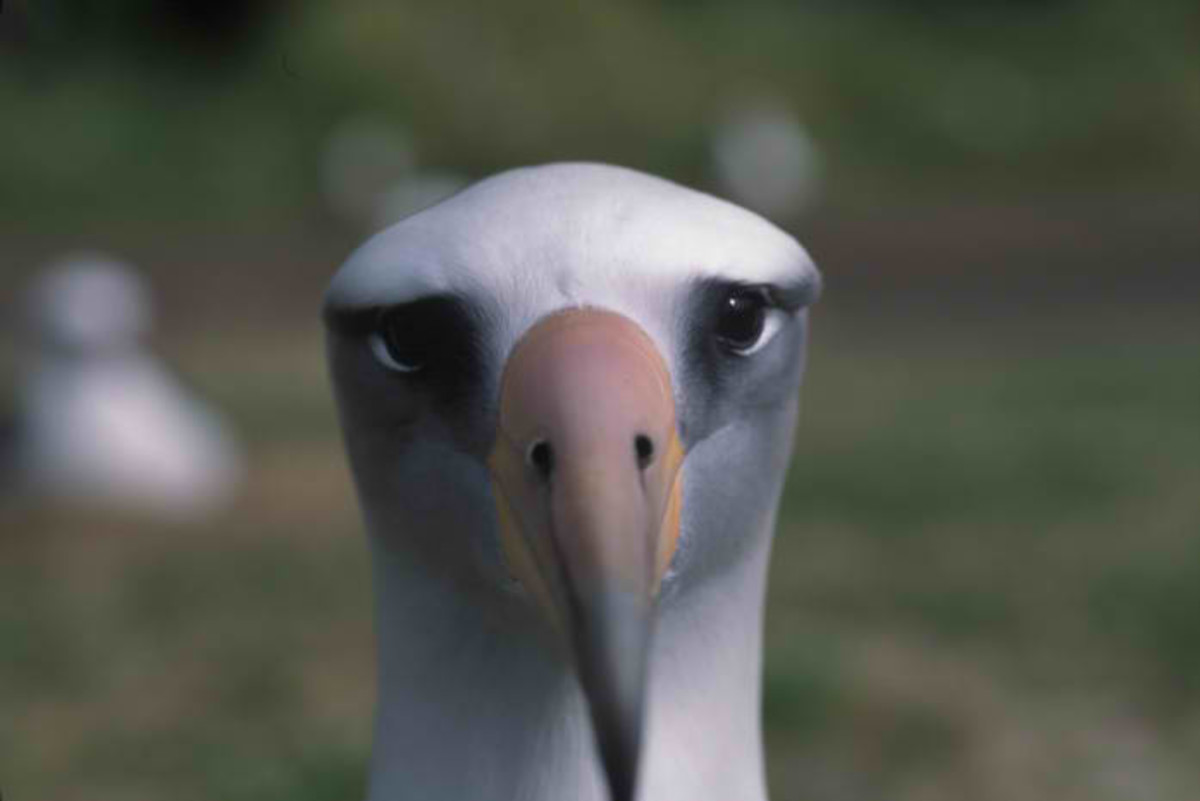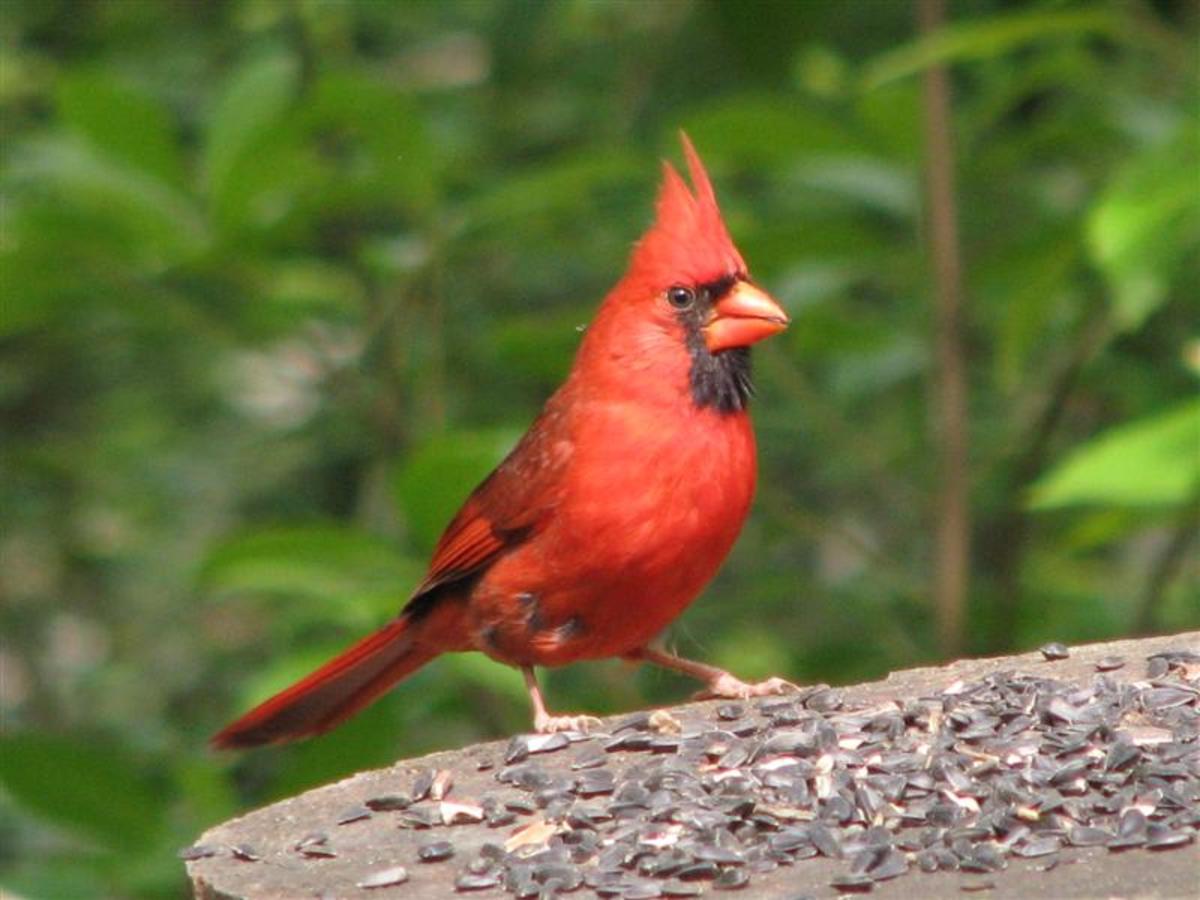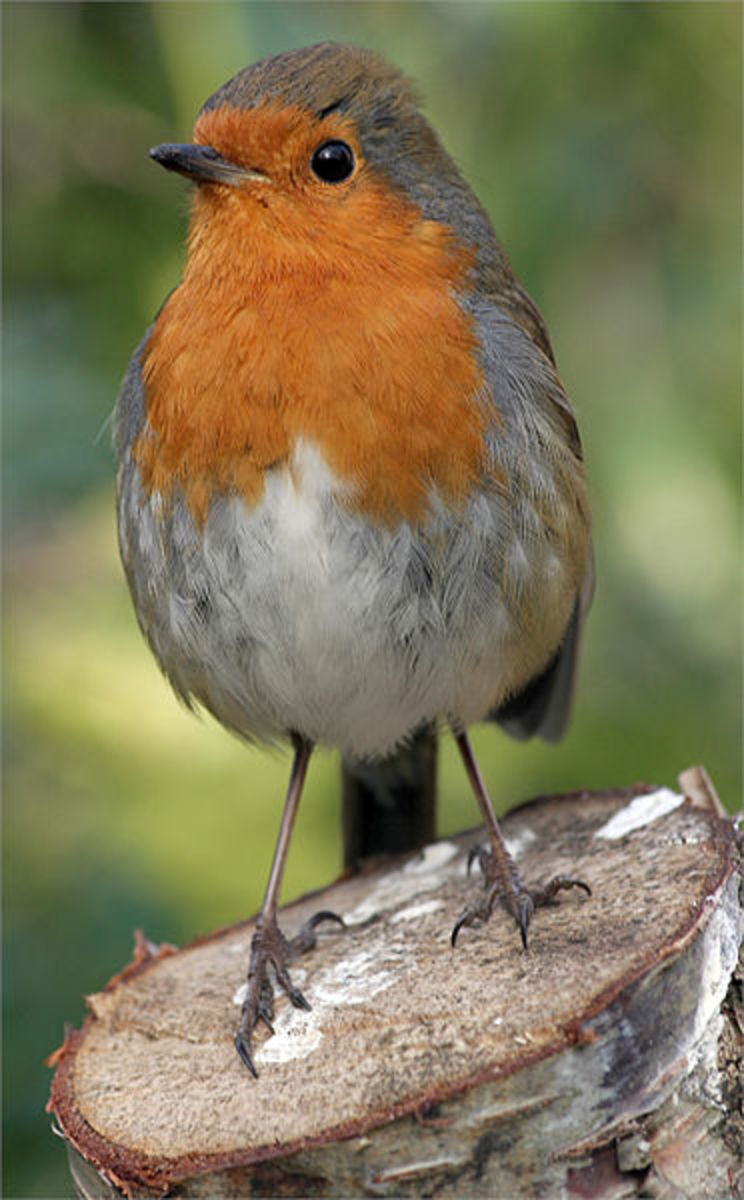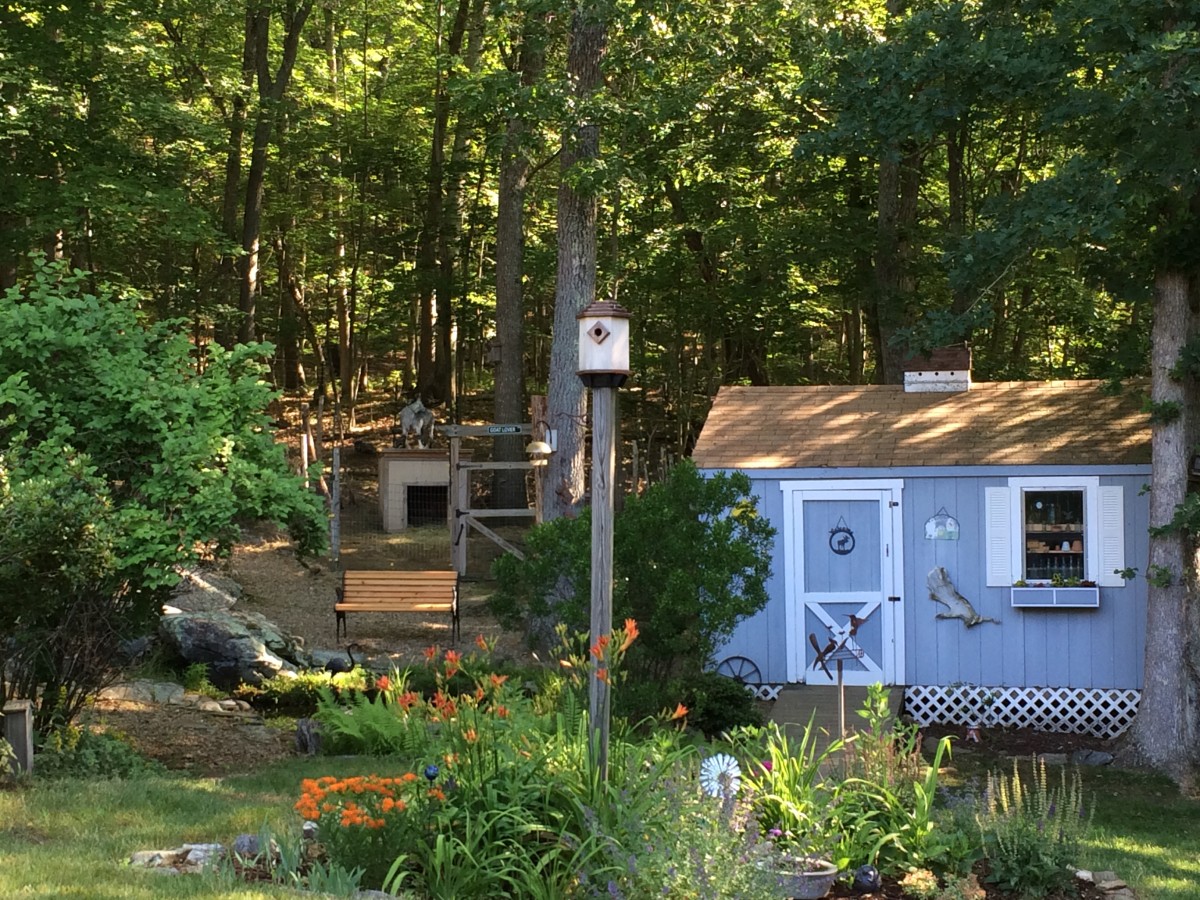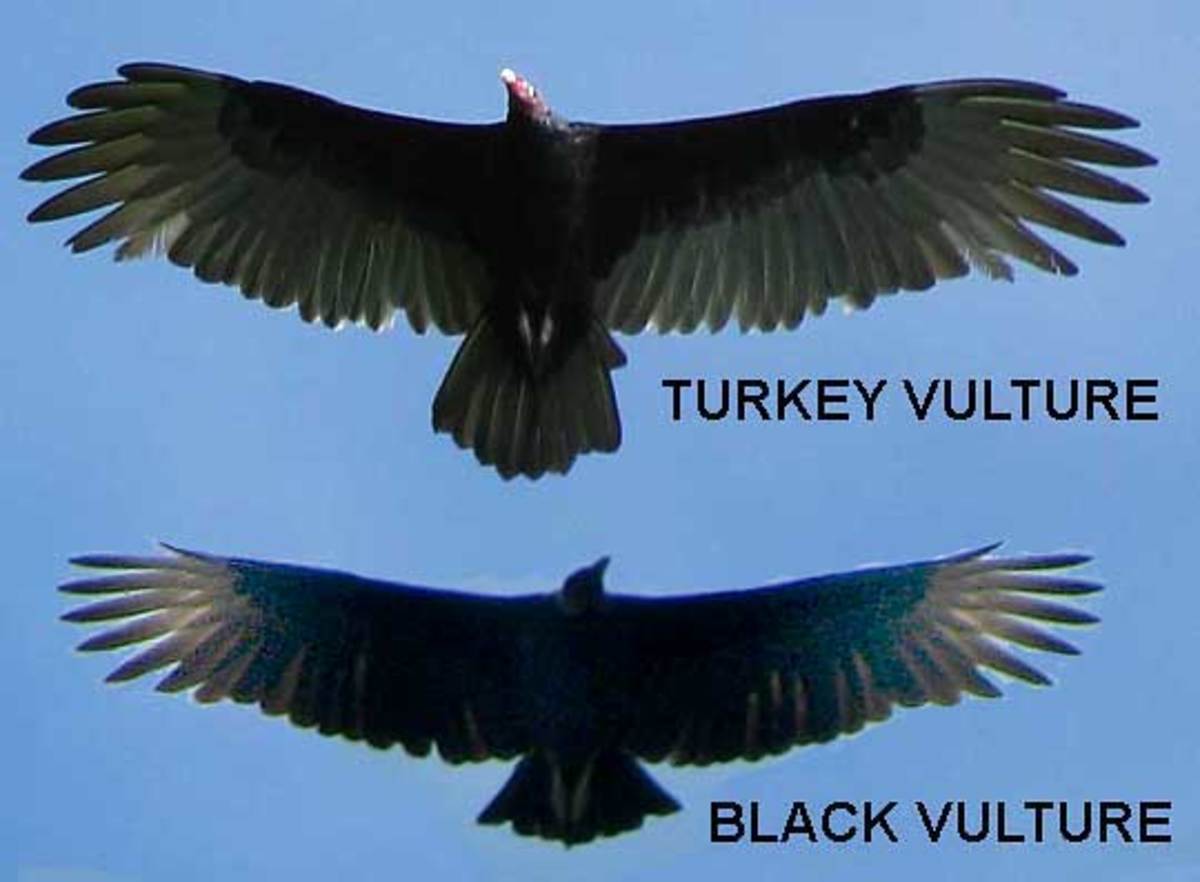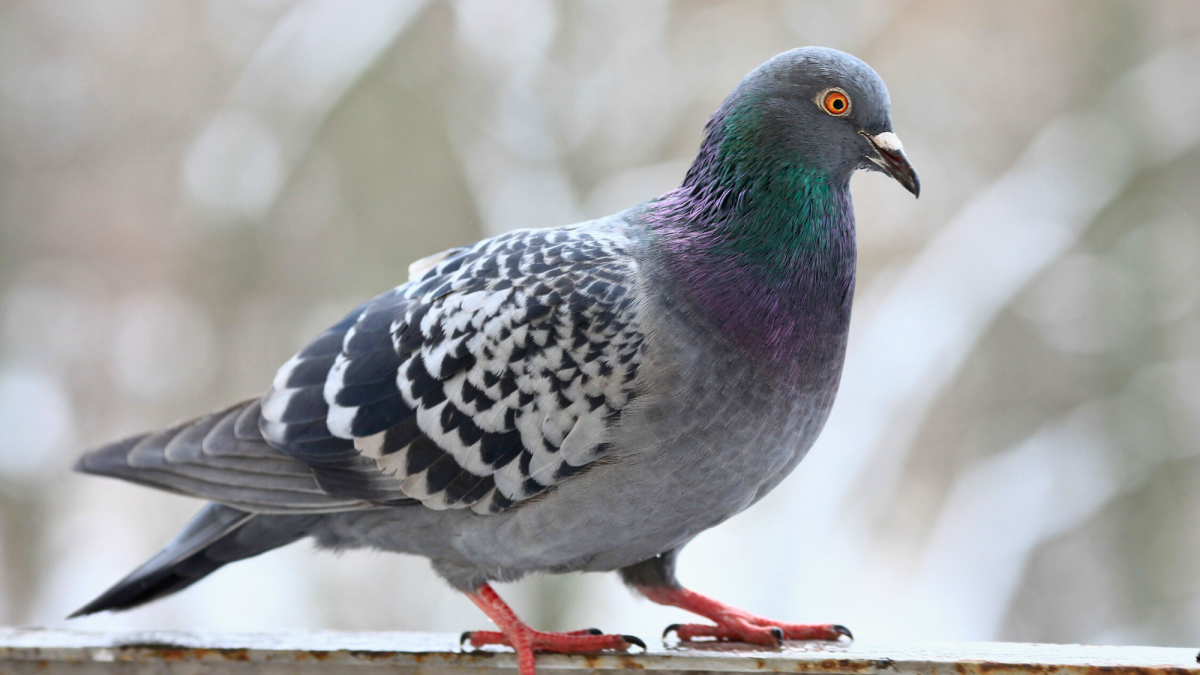Pictures of Birds - Prothonotary Warbler Nesting
Male Prothonotary in Bottlebrush
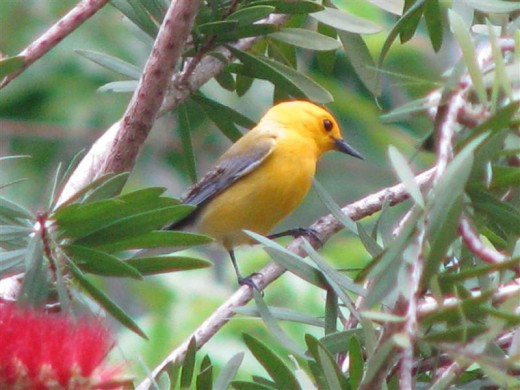
Golden Prothonotary Warblers
Prothonotary Warblers are beautiful small, golden yellow birds. We are lucky to have several pairs nesting in nest boxes and in natural cavities in our 9 acre habitat in South Louisiana. The Prothonotary is the only North American warbler which nests in cavities.
Recently a pair decided to nest in an ornamental butterfly shelter which is in a flower bed near our giant red Bottlebrush shrub/tree.
This was not the first time that a pair of Prothonotaries (PROW) chose such a spot to nest. Many years ago, another pair nested in a similar shelter box which was nailed to our gate post. In fact Prothonotary Warblers (PROW) will nest in all sorts of unusual places.
This page is a photo journal of the fledging of the baby Prothonotary Warblers which hatched on Mother's Day, May 8, 2011.
Nest in a Butterfly Shelter
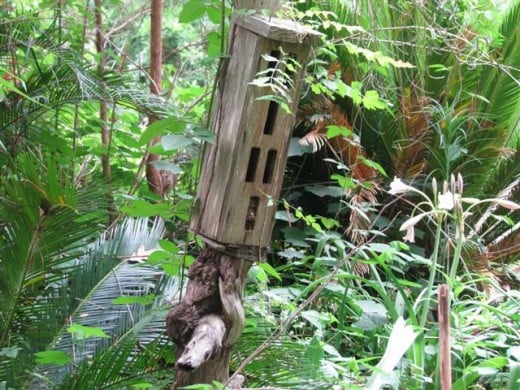

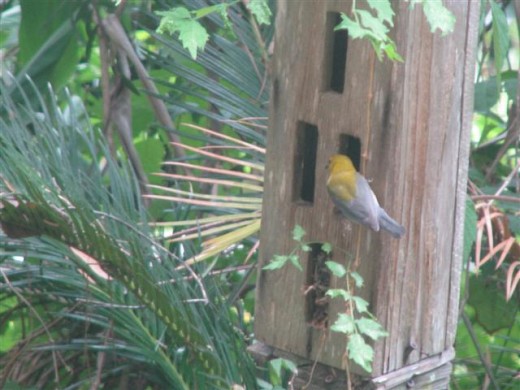
Female Bathing
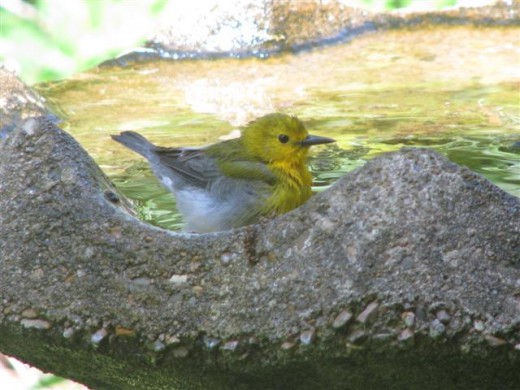
I first noticed the parents putting nesting material in the Butterfly shelter in April.
Before the females arrive, the male deposits some green moss to claim this spot (and others) as his. Later he enticed a female to view his chosen sites and she chose the butterfly shelter.
She did the rest of the nest building while he sang from the Mimosa tree. The nest consisted of bamboo leaves, green moss and some grasses.
Soon there were 5-6 eggs. It was hard to see exactly how many there were because I had to peek through the slot.
PROW warblers just don't follow the "rules" like Bluebirds. Nine times out of ten PROW will choose a tiny nesting cavity with no protection against predators.
They also like to nest near water. Our quarter acre pond is right behind the butterfly shelter and our birdbath is nearby, too. The female bathed in the birdbath daily during the long dry spell. The eggs must have some moisture to keep the shells pliable on the inside, so they young could easily peck their way out.
After 12-14 days of incubation, on May 18th, the eggs hatched. I think 3-4 babies hatched out, but again it's not easy to tell when you have to peer through a little slot. I didn't do this often because who knows what the birds think when they see "the big eye" staring at them.
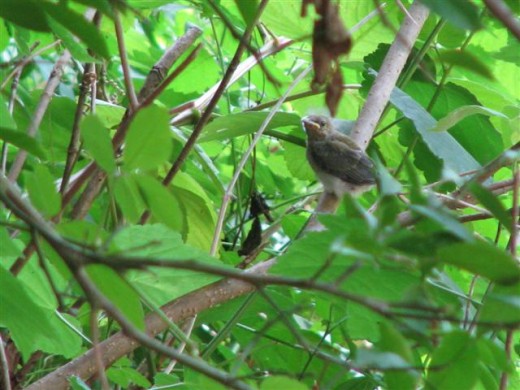
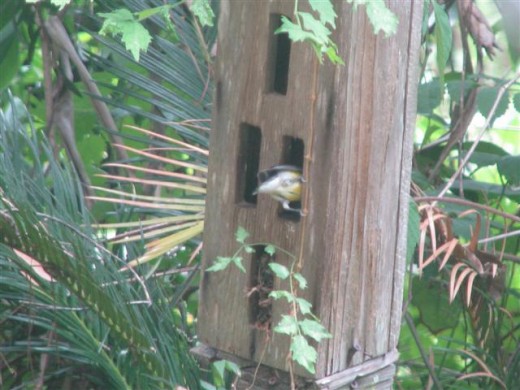
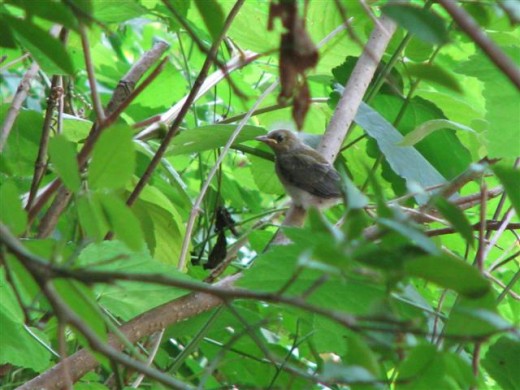
Last Fledgling
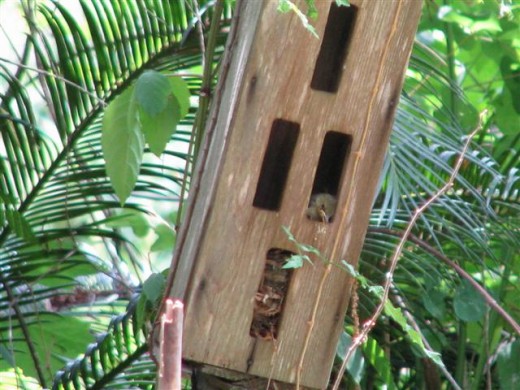
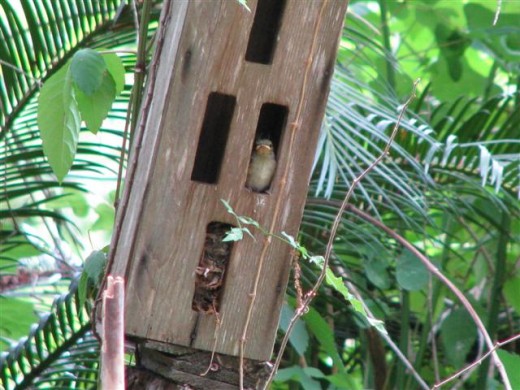
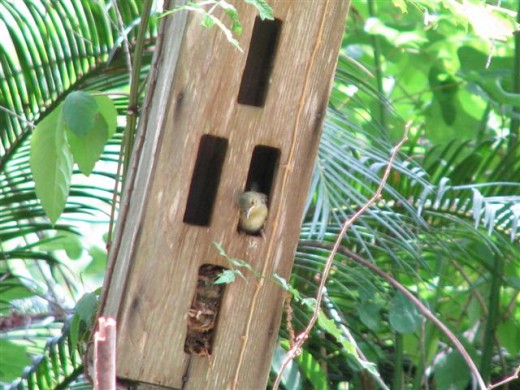
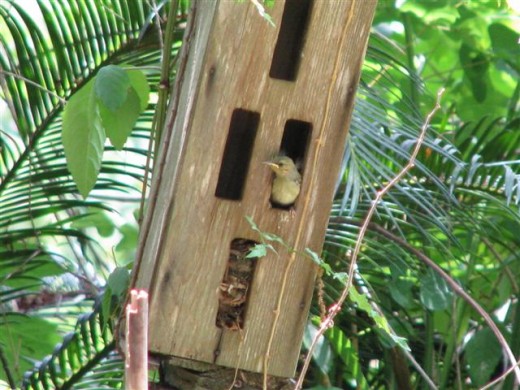
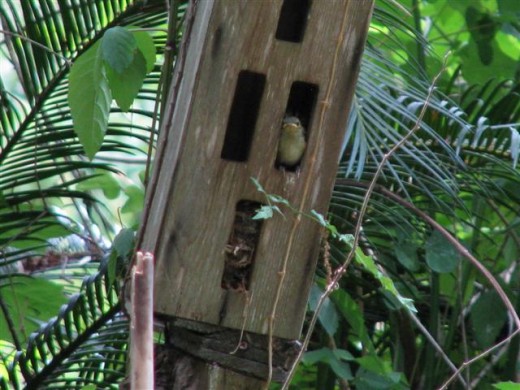

Prothonotary Babies Fledge
Exactly 11 days later, on May 19th, the babies fledged.
I almost missed it, because I was feeling low and had forgotten to open the curtain.
When I did around mid day, I saw one of the babies sticking its head out of a slot. I ran to get the camera and was back in time to get the mother feeding through the slot, but the first or second) baby flew out as I approached the window.
The rest of the shots were taken as I crouched in the open door. I was fortunate to see the second or third baby leave the nest. It's such a magical moment when the little bird finally decides to leave the nest.
All photos on this page are copyrighted by Y.L. Bordelon, all rights reserved.
Last Prothonotary to Leave the Nest
I was so happy that these baby Prothonotary Warblers all fledged safely. Prothonotary numbers are decreasing due to habitat destruction and predation by cowbirds and others. Their choice of cavities is not always the safest.
We have placed about 25 nest boxes suitable for PROW, bluebirds, Tufted Titmice, Carolina Wrens, Brown-headed Nuthatches and other small cavity nesters all over our habitat.
Some are used by Prothonotary Warblers, but PROW would just as soon use an old wren house, a cardboard milk carton or a cinder block.
There is always much deliberation on the part of the baby bird considering taking the leap out into the unknown. This one spent about 5 minutes looking this way and that. Some calling to the parents was done.
Then suddenly, its mind was made up and he took wing, landing in the American Beech tree, right above where I was sitting in the doorway.
Suitable Nest Boxes
Out in the Big, New World
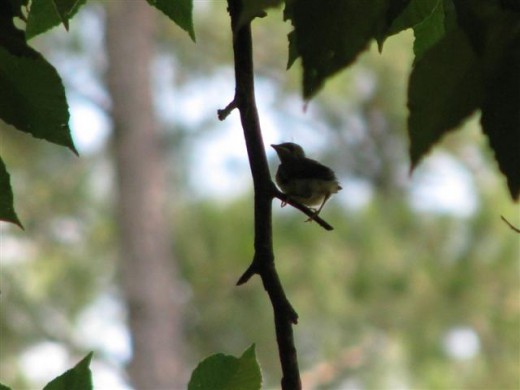

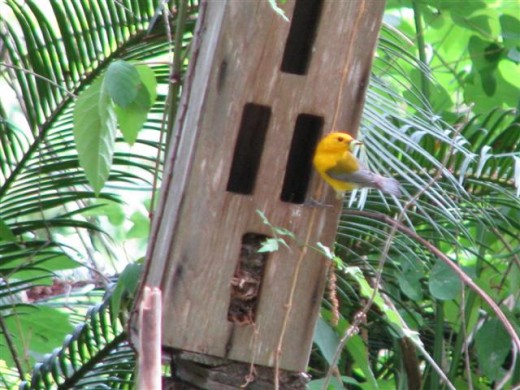
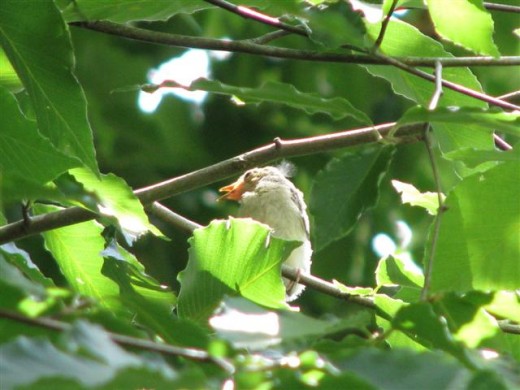

Out in the Big New World
The male PROW was a little confused when all the young had left the box.
He found a big, juicy green caterpillar and searched everywhere for the young and even went to look in the box.
Finally one of the little ones gave its "feed me" call from somewhere in the bushes.
This went on for the rest of the afternoon. Gradually the baby birds grew stronger and more sure of themselves and found places up higher for the night.
The next day the family had made their way to the clump bamboo. Hopefully all the young will survive to breed and increase the numbers of this lovely bird in our habitat on the Tchefuncte River.
A few days later, I looked into the butterfly box and saw that 2 of the 6 eggs had not hatched. I'm hoping that all 4 of the babies that hatched will grow to adult hood, but that is a very optimistic wish. They will be lucky if one out of the four live to breed.
All we can do is to provide the proper habitat and nesting sites. We keep two-thirds of out land in its natural state as forest and wetlands. We also do not cut down dead trees, unless they are threatening some structure.
Great Cameras

Prothonotary Poll
Do Prothonotary Warblers nest in your area?
Prothonotary Female Builds 2nd Nest

Back and Forth to the Creek for Moss
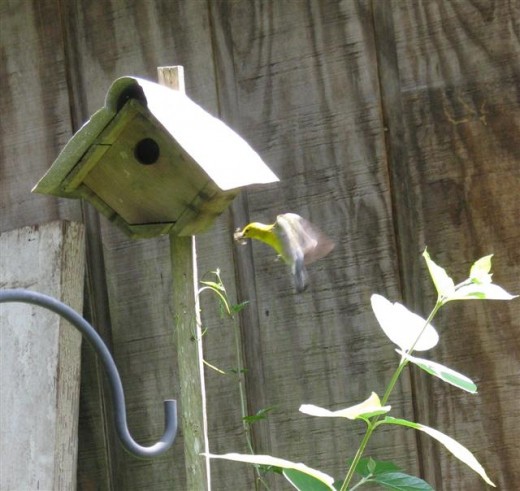
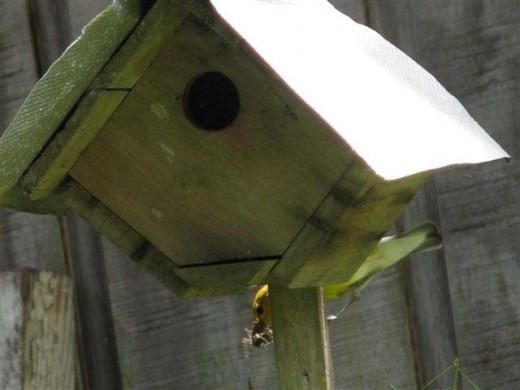
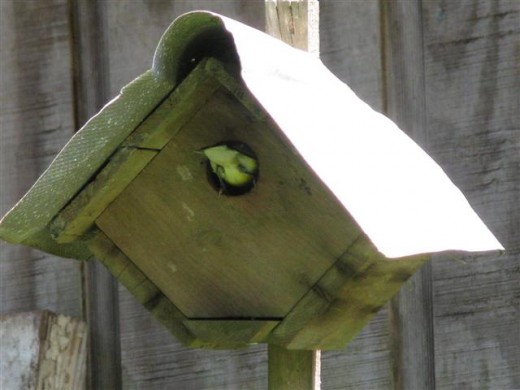


Second Nest for the Prothonotary Pair
Prothonotary Warblers usually nest twice while they are here in south Louisiana. Since they are only here a short time (usually from April to early August), they must get the process done quickly.
I am pleased to announce that the female PROW has begun building a second nest in another spot, the old wren birdhouse that is in the Memory Garden.
The great thing about this spot is that I can sit on the screen porch and watch the process. The not so great thing is that I never did get around to putting a predator baffle on the nest box pole and now that nesting has begun, I might frighten them away if I tried.
Yesterday the female was very busy bringing pieces of green moss from the creek which runs along the side of our habitat. She made countless trips, back and forth.
I was able to get some photos of her during her tireless task. Today, all is quiet, so I suppose she finished the nest or nearly so.
Egg laying will be next. She may wait a few days to do that. Then when the next to last egg is laid, she will begin incubating the eggs.
I can hear the male singing away up in the trees near the house.
Female Sitting on 2nd Nest
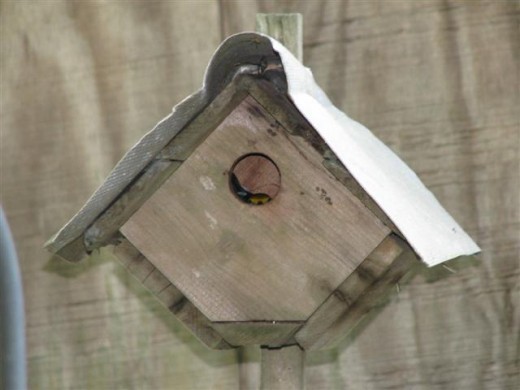
May 31 - Prothonotary Female Incubating 2nd Nest
The female Prothonotary Warbler was certainly a busy girl this week. I observed her building the nest in the Wren size nest box on May 23-24, then all was quiet. I heard the pair chirping and singing in the area, but did not observe either entering the nest box.
This morning, May 31, I was potting some plants about 10 feet from the nest box when the female sat on a branch above my head and continued to chirp her alarm call. I thought she may want to lay an egg in the box, so I went onto the screen porch. She quieted down immediately, so I came back out to finish up my potting a few minutes later.
This afternoon, I noticed what looked like her head peeking from the hole, so I got my binoculars and determined that she was sitting on the nest. Apparently, this morning was either the last, or the next to last egg for her and she has begun incubation.
We will count May 31 as day 1. In 12-14 days, if all goes well, the eggs will hatch. I will attempt to chronicle the events as they occur and may attempt to set up our automatic bird camera (if it still works) to catch some of the comings and goings.
Bringing Food to the Baby Prothonotaries
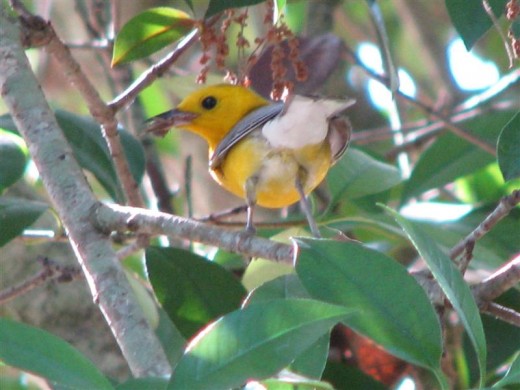
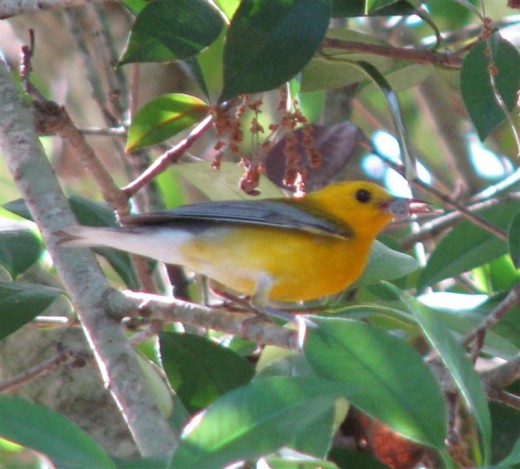

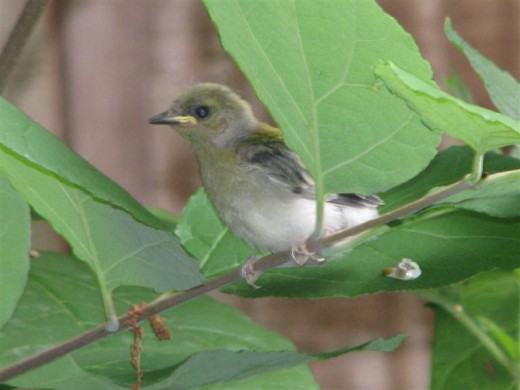
I Think the 2nd Set of Eggs Has Hatched!
The female Prothonotary is coming out of the house more and when I go near the nest box, when she leaves, I think I hear little cheeping sounds. This would be day 12 (June 12th).
Tomorrow morning I plan to sit on the back porch with the camera to try to get a picture. I'll post it if I can catch her bringing food in or taking poop out.
June 19th
The PROW Chicks are about one week old. Both parents are feeding the chicks. The male is bringing in what looks like small spiders. The female sits on a branch above the nest in between trips for food.
The male continues his happy song when he takes a break from catching food for the Prothonotary chicks.
It has not rained enough and drought conditions exist throughout south Louisiana. I put a sprayer hose in the Memory garden where the nest box is. This will help keep the area hydrated without wetting the nest box. Many of the insects that Prothonotaries catch to feed their young need moisture.
June 22
On a rainy afternoon, I observed the last baby Prothonotary Warbler leaving the nest box. I first saw it peeking out and ran to get the camera. I got back just in time to see it jump into the shrubs and plants in the Memory Garden.
It stayed, hidden in the leaves for a while so I was able to get a few foggy pictures. By the time the lens cleared up, it had moved a little. The afternoon was so dark, that I had to use a flash.
Mom and Dad PROW were "chitting" at me, so I went back on the porch and watched as the Mother coaxed it into deeper cover.
Hopefully these young will survive the migration to and from Costa Rica and will return next spring to raise babies of their own.
Prothonotary Warblers at Nestbox
For More Information About Prothonotary Warblers
- Prothonotary Warblers are Golden
Prothonotary Warblers are lovely little yellow birds with blue gray wings. They are becoming more rare as their wetland and swamp habitat is cleared and filled. If you live near water, you can help these perky little birds by erecting birdhouses and - Prothonotary Warbler (PROW) Nest, Eggs and Young
General information on how to attract nesting bluebirds, including distinguishing nests and eggs of other cavity nesters, heat, dealing with house sparrows, data on bluebird trail.
Male Prothonotary Bathing
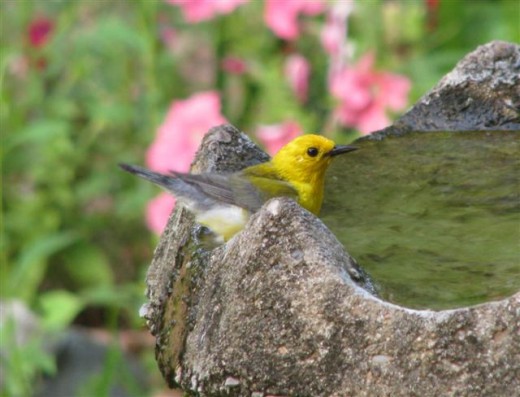
© 2011 Yvonne L. B.
